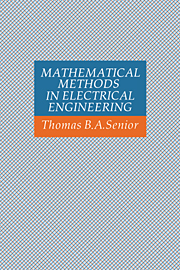Chapter 3 - Linear systems
Published online by Cambridge University Press: 05 June 2012
Summary
Having now arrived at the heart of our subject, we show how the mathematical techniques that have been discussed can be used to solve some of the problems associated with linear systems.
Basic concepts
In its most general form a system is any physical device that when stimulated or excited, produces a response. The system could be as complicated as (a model of) the human brain or as simple as an electrical circuit with a lumped resistance, and the problem the engineer could face is to determine the response or output of the system resulting from a known excitation or input. To develop procedures that are applicable to a variety of systems, it is necessary to restrict the type of system considered.
Physical description
For the systems of concern to us it is assumed that the input and output are functions of a single real variable t, which we shall speak of as time, and that a causal relationship exists between the two. The term causal implies that the output is a function of the input alone, and because of this, the system is “nonanticipatory” that is, there is no output until the input is applied. This is an attribute of all physically realizable systems. For convenience we shall refer to the input and output as signals, and if these are denoted by f(t) and x(t), respectively, a system can be depicted as shown in Fig. 3.1.
Information
- Type
- Chapter
- Information
- Mathematical Methods in Electrical Engineering , pp. 49 - 96Publisher: Cambridge University PressPrint publication year: 1986
